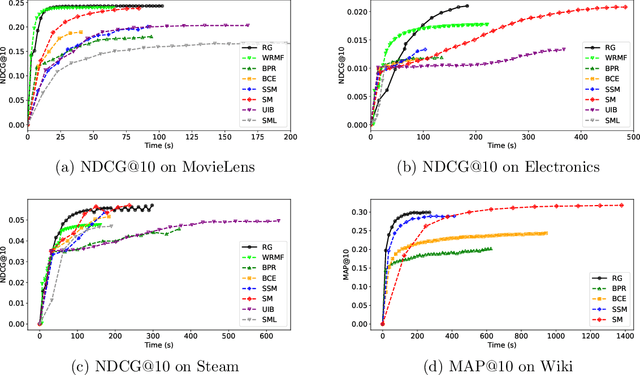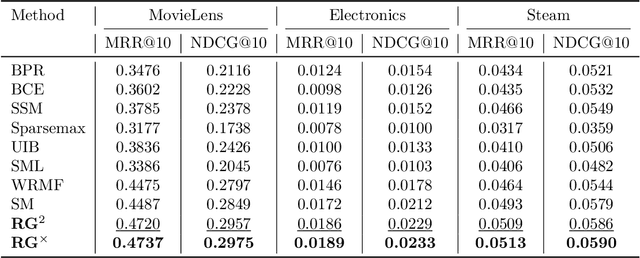Defu Lian
LLM Cache Bandit Revisited: Addressing Query Heterogeneity for Cost-Effective LLM Inference
Sep 19, 2025Abstract:This paper revisits the LLM cache bandit problem, with a special focus on addressing the query heterogeneity for cost-effective LLM inference. Previous works often assume uniform query sizes. Heterogeneous query sizes introduce a combinatorial structure for cache selection, making the cache replacement process more computationally and statistically challenging. We treat optimal cache selection as a knapsack problem and employ an accumulation-based strategy to effectively balance computational overhead and cache updates. In theoretical analysis, we prove that the regret of our algorithm achieves an $O(\sqrt{MNT})$ bound, improving the coefficient of $\sqrt{MN}$ compared to the $O(MN\sqrt{T})$ result in Berkeley, where $N$ is the total number of queries and $M$ is the cache size. Additionally, we also provide a problem-dependent bound, which was absent in previous works. The experiment rely on real-world data show that our algorithm reduces the total cost by approximately 12\%.
OmniGen2: Exploration to Advanced Multimodal Generation
Jun 23, 2025Abstract:In this work, we introduce OmniGen2, a versatile and open-source generative model designed to provide a unified solution for diverse generation tasks, including text-to-image, image editing, and in-context generation. Unlike OmniGen v1, OmniGen2 features two distinct decoding pathways for text and image modalities, utilizing unshared parameters and a decoupled image tokenizer. This design enables OmniGen2 to build upon existing multimodal understanding models without the need to re-adapt VAE inputs, thereby preserving the original text generation capabilities. To facilitate the training of OmniGen2, we developed comprehensive data construction pipelines, encompassing image editing and in-context generation data. Additionally, we introduce a reflection mechanism tailored for image generation tasks and curate a dedicated reflection dataset based on OmniGen2. Despite its relatively modest parameter size, OmniGen2 achieves competitive results on multiple task benchmarks, including text-to-image and image editing. To further evaluate in-context generation, also referred to as subject-driven tasks, we introduce a new benchmark named OmniContext. OmniGen2 achieves state-of-the-art performance among open-source models in terms of consistency. We will release our models, training code, datasets, and data construction pipeline to support future research in this field. Project Page: https://vectorspacelab.github.io/OmniGen2; GitHub Link: https://github.com/VectorSpaceLab/OmniGen2
NDCG-Consistent Softmax Approximation with Accelerated Convergence
Jun 11, 2025



Abstract:Ranking tasks constitute fundamental components of extreme similarity learning frameworks, where extremely large corpora of objects are modeled through relative similarity relationships adhering to predefined ordinal structures. Among various ranking surrogates, Softmax (SM) Loss has been widely adopted due to its natural capability to handle listwise ranking via global negative comparisons, along with its flexibility across diverse application scenarios. However, despite its effectiveness, SM Loss often suffers from significant computational overhead and scalability limitations when applied to large-scale object spaces. To address this challenge, we propose novel loss formulations that align directly with ranking metrics: the Ranking-Generalizable \textbf{squared} (RG$^2$) Loss and the Ranking-Generalizable interactive (RG$^\times$) Loss, both derived through Taylor expansions of the SM Loss. Notably, RG$^2$ reveals the intrinsic mechanisms underlying weighted squared losses (WSL) in ranking methods and uncovers fundamental connections between sampling-based and non-sampling-based loss paradigms. Furthermore, we integrate the proposed RG losses with the highly efficient Alternating Least Squares (ALS) optimization method, providing both generalization guarantees and convergence rate analyses. Empirical evaluations on real-world datasets demonstrate that our approach achieves comparable or superior ranking performance relative to SM Loss, while significantly accelerating convergence. This framework offers the similarity learning community both theoretical insights and practically efficient tools, with methodologies applicable to a broad range of tasks where balancing ranking quality and computational efficiency is essential.
How to Unlock Time Series Editing? Diffusion-Driven Approach with Multi-Grained Control
Jun 05, 2025Abstract:Recent advances in time series generation have shown promise, yet controlling properties in generated sequences remains challenging. Time Series Editing (TSE) - making precise modifications while preserving temporal coherence - consider both point-level constraints and segment-level controls that current methods struggle to provide. We introduce the CocktailEdit framework to enable simultaneous, flexible control across different types of constraints. This framework combines two key mechanisms: a confidence-weighted anchor control for point-wise constraints and a classifier-based control for managing statistical properties such as sums and averages over segments. Our methods achieve precise local control during the denoising inference stage while maintaining temporal coherence and integrating seamlessly, with any conditionally trained diffusion-based time series models. Extensive experiments across diverse datasets and models demonstrate its effectiveness. Our work bridges the gap between pure generative modeling and real-world time series editing needs, offering a flexible solution for human-in-the-loop time series generation and editing. The code and demo are provided for validation.
What Makes a Good Reasoning Chain? Uncovering Structural Patterns in Long Chain-of-Thought Reasoning
May 28, 2025



Abstract:Recent advances in reasoning with large language models (LLMs) have popularized Long Chain-of-Thought (LCoT), a strategy that encourages deliberate and step-by-step reasoning before producing a final answer. While LCoTs have enabled expert-level performance in complex tasks, how the internal structures of their reasoning chains drive, or even predict, the correctness of final answers remains a critical yet underexplored question. In this work, we present LCoT2Tree, an automated framework that converts sequential LCoTs into hierarchical tree structures and thus enables deeper structural analysis of LLM reasoning. Using graph neural networks (GNNs), we reveal that structural patterns extracted by LCoT2Tree, including exploration, backtracking, and verification, serve as stronger predictors of final performance across a wide range of tasks and models. Leveraging an explainability technique, we further identify critical thought patterns such as over-branching that account for failures. Beyond diagnostic insights, the structural patterns by LCoT2Tree support practical applications, including improving Best-of-N decoding effectiveness. Overall, our results underscore the critical role of internal structures of reasoning chains, positioning LCoT2Tree as a powerful tool for diagnosing, interpreting, and improving reasoning in LLMs.
GenKI: Enhancing Open-Domain Question Answering with Knowledge Integration and Controllable Generation in Large Language Models
May 26, 2025Abstract:Open-domain question answering (OpenQA) represents a cornerstone in natural language processing (NLP), primarily focused on extracting answers from unstructured textual data. With the rapid advancements in Large Language Models (LLMs), LLM-based OpenQA methods have reaped the benefits of emergent understanding and answering capabilities enabled by massive parameters compared to traditional methods. However, most of these methods encounter two critical challenges: how to integrate knowledge into LLMs effectively and how to adaptively generate results with specific answer formats for various task situations. To address these challenges, we propose a novel framework named GenKI, which aims to improve the OpenQA performance by exploring Knowledge Integration and controllable Generation on LLMs simultaneously. Specifically, we first train a dense passage retrieval model to retrieve associated knowledge from a given knowledge base. Subsequently, we introduce a novel knowledge integration model that incorporates the retrieval knowledge into instructions during fine-tuning to intensify the model. Furthermore, to enable controllable generation in LLMs, we leverage a certain fine-tuned LLM and an ensemble based on text consistency incorporating all coherence, fluency, and answer format assurance. Finally, extensive experiments conducted on the TriviaQA, MSMARCO, and CMRC2018 datasets, featuring diverse answer formats, have demonstrated the effectiveness of GenKI with comparison of state-of-the-art baselines. Moreover, ablation studies have disclosed a linear relationship between the frequency of retrieved knowledge and the model's ability to recall knowledge accurately against the ground truth. Our code of GenKI is available at https://github.com/USTC-StarTeam/GenKI
DLF: Enhancing Explicit-Implicit Interaction via Dynamic Low-Order-Aware Fusion for CTR Prediction
May 25, 2025Abstract:Click-through rate (CTR) prediction is a critical task in online advertising and recommender systems, relying on effective modeling of feature interactions. Explicit interactions capture predefined relationships, such as inner products, but often suffer from data sparsity, while implicit interactions excel at learning complex patterns through non-linear transformations but lack inductive biases for efficient low-order modeling. Existing two-stream architectures integrate these paradigms but face challenges such as limited information sharing, gradient imbalance, and difficulty preserving low-order signals in sparse CTR data. We propose a novel framework, Dynamic Low-Order-Aware Fusion (DLF), which addresses these limitations through two key components: a Residual-Aware Low-Order Interaction Network (RLI) and a Network-Aware Attention Fusion Module (NAF). RLI explicitly preserves low-order signals while mitigating redundancy from residual connections, and NAF dynamically integrates explicit and implicit representations at each layer, enhancing information sharing and alleviating gradient imbalance. Together, these innovations balance low-order and high-order interactions, improving model expressiveness. Extensive experiments on public datasets demonstrate that DLF achieves state-of-the-art performance in CTR prediction, addressing key limitations of existing models. The implementation is publicly available at https://github.com/USTC-StarTeam/DLF.
The Real Barrier to LLM Agent Usability is Agentic ROI
May 23, 2025Abstract:Large Language Model (LLM) agents represent a promising shift in human-AI interaction, moving beyond passive prompt-response systems to autonomous agents capable of reasoning, planning, and goal-directed action. Despite the widespread application in specialized, high-effort tasks like coding and scientific research, we highlight a critical usability gap in high-demand, mass-market applications. This position paper argues that the limited real-world adoption of LLM agents stems not only from gaps in model capabilities, but also from a fundamental tradeoff between the value an agent can provide and the costs incurred during real-world use. Hence, we call for a shift from solely optimizing model performance to a broader, utility-driven perspective: evaluating agents through the lens of the overall agentic return on investment (Agent ROI). By identifying key factors that determine Agentic ROI--information quality, agent time, and cost--we posit a zigzag development trajectory in optimizing agentic ROI: first scaling up to improve the information quality, then scaling down to minimize the time and cost. We outline the roadmap across different development stages to bridge the current usability gaps, aiming to make LLM agents truly scalable, accessible, and effective in real-world contexts.
EquivPruner: Boosting Efficiency and Quality in LLM-Based Search via Action Pruning
May 22, 2025Abstract:Large Language Models (LLMs) excel at complex reasoning through search algorithms, yet current strategies often suffer from massive token consumption due to redundant exploration of semantically equivalent steps. Existing semantic similarity methods struggle to accurately identify such equivalence in domain-specific contexts like mathematical reasoning. To address this, we propose EquivPruner, a simple yet effective approach that identifies and prunes semantically equivalent actions during LLM reasoning search. We also introduce MathEquiv, the first dataset we created for mathematical statement equivalence, which enables the training of a lightweight equivalence detector. Extensive experiments across various models and tasks demonstrate that EquivPruner significantly reduces token consumption, improving searching efficiency and often bolstering reasoning accuracy. For instance, when applied to Qwen2.5-Math-7B-Instruct on GSM8K, EquivPruner reduced token consumption by 48.1\% while also improving accuracy. Our code is available at https://github.com/Lolo1222/EquivPruner.
Towards A Generalist Code Embedding Model Based On Massive Data Synthesis
May 19, 2025Abstract:Code embedding models attract increasing attention due to the widespread popularity of retrieval-augmented generation (RAG) in software development. These models are expected to capture the rich semantic relationships inherent to code, which differ significantly from those found in text. However, existing models remain severely limited due to the scarcity of high-quality training data. In this work, we introduce \textbf{CodeR} (\underline{Code} \underline{R}etrieval), a state-of-the-art embedding model for general-purpose code retrieval. The superior performance of CodeR is built upon CodeR-Pile, a large-scale synthetic dataset constructed under the DRU (Diversity, Reliability, Usability) principle via a novel data synthesis pipeline. To optimize training effectiveness, we propose Annealing, a curriculum learning strategy that enables effective knowledge transfer across heterogeneous sources of data. We evaluate CodeR based on 16 diverse code retrieval tasks, where it significantly outperforms existing baselines and exhibits strong out-of-domain generalization performance. We have publicly released our code and the well-trained model to facilitate further research in this critical area. https://github.com/FlagOpen/FlagEmbedding/tree/master/research/BGE_Coder.
 Add to Chrome
Add to Chrome Add to Firefox
Add to Firefox Add to Edge
Add to Edge